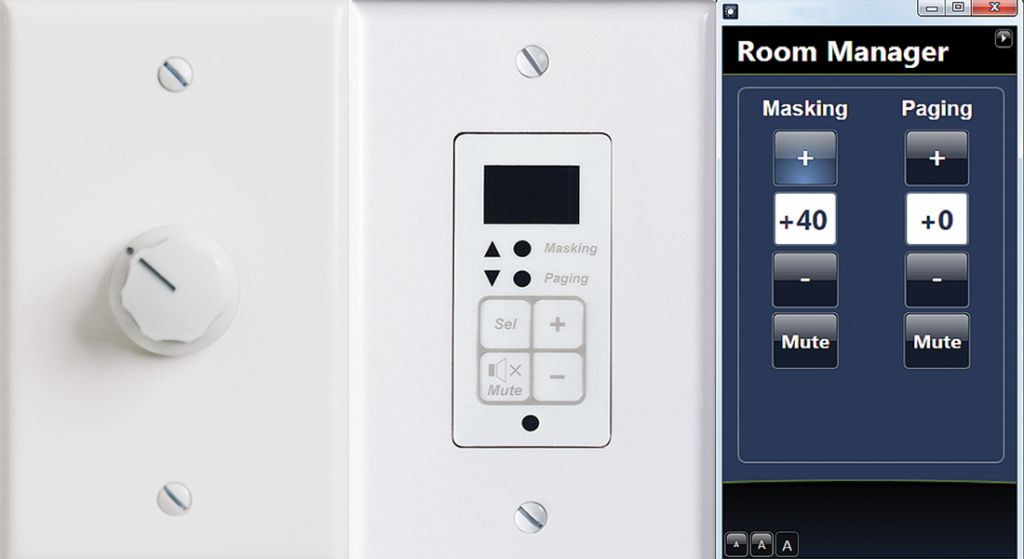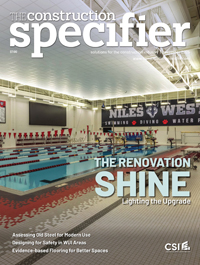Hospital quiet zone

by Niklas Moeller
Conversations and the cacophony emanating from telephones, alarms, televisions, carts, doors, medical, and mechanical equipment ensure noise is ever-present in U.S. hospitals. Various economic incentives, regulatory measures, and design guidelines have been developed over the past decade to encourage hospitals to address this problem.
It is important for those involved in the planning and construction of these facilities to understand these initiatives, as well as how to help hospital administrators achieve their acoustic goals.
One of the most powerful measures is the value-based purchasing program (VBP) enacted by the Centers for Medicare and Medicaid Services (CMS). It provides monetary incentive to improve patient outcomes by penalizing poorly performing hospitals, while rewarding those that do better. At its outset, it was funded by a one percent withholding of Medicare. In 2014, that figure began rising by 0.25 percent annually and will reach its currently planned cap of two percent by 2017.
The VBP program is rooted in a total performance score for each hospital calculated from clinical quality assessments (70 percent) and patient satisfaction scores (30 percent). The latter is based on the results of the Hospital Consumer Assessment of Healthcare Providers and Systems (HCAHPS) survey. Failure to submit these surveys to CMS results in a two percent withholding ?of Medicare.
The HCAHPS (pronounced ‘h-caps’) survey is given to a random sample of patients between 48 hours and six weeks after discharge, and is used to gain insight into perspectives on the quality of their hospital stay. It includes 18 questions, grouped under eight topics. Hospitals earn points for achieving a certain performance level relative to other hospitals, for improving their performance over previous periods, and for consistency across all eight categories.
The section pertaining to the hospital environment includes a question relating to noise that asks, “During this hospital stay, how often was the area around your room quiet at night?” The patient can respond: never, sometimes, usually, or always. Since 2007—when collecting and submitting the survey became mandatory—noise has consistently been the worst-rated factor nationwide. As such, this problem has the greatest potential to impact hospital funding by dragging down consistency scores as well as patients’ overall rating of their stay. It may also affect a hospital’s competitiveness because the public can review each facility’s results online.

Patient comfort and outcomes
It is worth noting the HCAHPS survey focuses on the quietness of the patient’s room at night. Though noise is not responsible for all sleep disruptions, its contribution is significant.
Researchers have found the sick and the elderly are the most likely to have their sleep disturbed by noise, and people never completely habituate themselves to night-time noise. Noise reduces both the quantity and quality of sleep through delayed onset, shifts to lighter stages, motility (i.e. tossing and turning), and awakenings, which weaken the immune system and impede the body’s ability to generate new cells. It can also lead to problems during the day, such as agitation and delirium.
However, a growing body of medical studies show noise also causes problems during the day. As illness can increase sensitivity to environmental stressors, noise can create anxiety, driving up nursing calls as well as pain medication requests. In fact, side effects such as elevated blood pressure, quickened heart rate, and increased metabolism have led some researchers to conclude noise may even slow recovery rates and length hospital stays.
Additionally, patients are not the only ones affected. Though one might think staff can become conditioned to noise over time, no one is able to fully tune out these disturbances because senses are designed to detect such changes in the environment. Both the American Hospital Association (AHA) and the Institute for Safe Medical Practices (ISMP) recommend that medical error prevention programs take noise into consideration, given it can impact caregivers’ concentration, stress levels, and fatigue.
HIPAA and speech privacy
Speech privacy is yet another acoustic concern in hospitals. Conversations occur at administrative stations, and in hallways and semi-private rooms. Often, areas used for the input and retrieval of both medical and financial information are located near waiting areas.
Patients know if they can overhear conversations occurring in adjacent areas, others can hear them as well, making them uncomfortable and less likely to discuss private matters with their caregiver. They also have a fundamental right to auditory privacy, which has been officially recognized in a set of federal regulations developed by the U.S. Department of Health and Human Services (HHS).
Introduced in 1996, the Health Insurance Portability and Accountability Act (HIPAA) primarily deals with the use of protected health information (PHI) and of any individually identifiable health information, as well as its storage, and sharing in electronic systems. However, a small but essential part of the HIPAA pertains to oral communication, because to exclude conversations would essentially allow for private information to be inappropriately shared if it was done verbally.
HIPAA requires healthcare entities take “reasonable safeguards”—including administrative, technical, and physical measures—to ensure speech privacy during both in-person and telephone conversations with patients and between employees. Compliance was required by healthcare-related facilities and other organizations working with PHI as of April 14, 2003. There are stated penalties for non-compliance, but HHS has elected to address speech privacy issues on a complaint basis to date, and few monetary penalties have been issued. However, a hospital must be able to demonstrate it has investigated acoustics, researched possible solutions, and implemented economically viable ones.

Improving acoustics using the ABCs
If one focuses on the types of noise created by building occupants and small medical equipment rather than structure-borne or mechanical sources, there are three key ways to improve noise control and speech privacy in hospitals: absorbing, blocking, and covering. None of these methods can achieve the desired goals on its own; rather, they must be used in combination. The further challenge in hospitals is to apply them in such a way so as not to compromise cleanliness or staff’s ability to easily access patients and interact with one another.
Using absorptive materials
Hospitals often have hard finishes, causing noises to echo, overlap, linger, and travel great distances. Adding absorptive materials still meeting the criteria for sterility and washability will reduce the energy and, therefore, the volume of noise reflected off their surfaces back into the space.
Since the ceiling is usually the largest unbroken surface in a facility, a good absorptive tile helps lessen the distance over which noises and conversations can be heard. In fact, a Swedish study determined cardiac patients in rooms with absorptive ceiling tiles were less likely to be readmitted than those in traditional rooms.
Ceiling absorption is often rated using noise reduction coefficient (NRC), which ranges from 0 to 1 (i.e. 0 to 100 percent absorption). Articulation class (AC) and ceiling attenuation class (CAC) are two additional ratings to consider. AC is the measure of the tile’s ability to absorb noise reflected off the ceiling into neighboring spaces in open-plan areas in the frequencies important for speech privacy. CAC indicates the tile’s value as a barrier to airborne sound transmission between adjacent closed offices, which is less relevant in hospitals where deck-to-deck construction is typically used. An appropriate tile should be specified and consistent coverage ensured throughout the building.
The ceiling’s absorptive power is affected by the type of lighting system used. From an acoustic perspective, the best lighting is an indirect system because it helps to maintain the coverage of the acoustical tile across the entire ceiling. A system incorporating a minimum number of fixtures while still meeting the lighting requirements should be specified.
Hanging absorptive wall panels may be needed in some situations. They are most effective when applied to large vertical surfaces and reflective locations, such as corridors. Acoustic wall panels are available featuring photographs or artwork.
Soft flooring can be used to lessen footfall and other ‘traffic’ noise. The challenge for hospitals is to implement it in a manner that does not compromise sanitation or hamper the movement of patients and equipment. Some have purchased motorized beds and use modular carpet tiles so individual sections can be removed for easier cleaning.

Implementing blocking strategies
When introduced to blocking, most people immediately think of walls, but a well-planned layout can also be used to minimize direct (i.e. line of sight) transmission of sound to and from neighboring spaces. For example, high-activity areas and noisy machines such as icemakers should be located in spaces well-separated from patient rooms. Doors facing each other across hallways should be offset. It is also helpful to rethink traditional aspects of the hospital landscape. For instance, nursing stations can be decentralized in order to prevent large groups from talking near patient rooms.
However, caution needs to be taken when applying blocking strategies, because caregivers must to be able to readily monitor and access patients. When one blocks out noise, the line of sight is also affected.
The most common blocking tactic is to construct deck-to-deck walls. The aim is to completely seal the room, but wall performance is sensitive to any gaps. Basically, if light can pass through, so can sound, and often well enough to substantially reduce the wall’s impact.
Of course, an open door is a private room’s biggest Achilles’ heel and some hospitals are re-e
valuating the open-door policy in an attempt to address this weakness. However, even when the door is closed, sound can transmit through HVAC components, openings under doors, and even back-to-back electrical switches and outlets. Any penetrations must be properly treated and managed during design, construction, maintenance, and renovation to ensure the wall’s integrity.
Covering noise with sound masking
When a closed room fails to provide speech privacy and control noise, some argue it is due to poor design or construction. While there is some truth to this position, it erroneously assumes the correct approach is to rely solely on physical isolation.
In fact, both blocking and absorption only address part of the acoustic equation. These strategies are needed to reduce volume peaks, the distance over which sounds travel, and the length of time they last. They also decrease a facility’s overall background sound level. The lower level makes remaining noises more noticeable and disruptive to occupants. It also allows them to clearly overhear conversations, even those occurring at a distance or in another room.

Providing a higher and more consistent background sound level is accomplished by installing a sound masking system. This technology basically consists of a series of loudspeakers integrated in a grid-like pattern above the ceiling, as well as a method of controlling their zoning and output. The loudspeakers distribute a comfortable sound, similar to softly blowing air.
Adding more sound to a space may run contrary to most people’s understanding of how to control noise, but the premise behind masking is simple: any noises below the new background sound level are covered up, while the impact of those above it is lessened because the degree of change between the baseline and any volume peaks is smaller.
Sound masking’s ability to reduce the quantity and severity of volume changes also makes it an effective method of improving sleeping conditions. In fact, in a 2005 study of intensive care unit (ICU) patients, quality of sleep improved by nearly 43 percent when sound masking was used.
Masking also entirely covers conversations or reduces intelligibility, improving privacy. However, this effect requires some distance and, therefore, masking does not prevent staff and patients from communicating with one another.
There are several design considerations worth noting when procuring this type of system for a hospital. For example, these environments are often highly fragmented, increasing emphasis on the requirement for numerous masking control zones.
Additionally, because opening the ceiling has the potential to spread contaminants into the occupied space below, the system should provide localized adjustment of all output settings and paging zones from a location below the ceiling (e.g. a control panel or computer). One does not want to have to put a containment system in place when changes need to be made to settings.
A networked-decentralized sound masking design will provide the required small zones (i.e. one to three loudspeakers), while allowing hospitals to make adjustments without reopening the ceiling or incurring significant disruption to their operations. It will also allow patients and staff to adjust the masking levels according to individual needs, as described ?in the 2014 Facility Guidelines Institute (FGI) Guidelines for Hospitals and Outpatient Facilities. In this way, the system will not only improve comfort, but also increase patients’ sense of control over their environmental conditions, raising satisfaction levels and HCAHPS scores.

Reducing noise through policy
While most of the acoustical burden must be borne by the facility’s design as outlined in ?this article, efforts to control noise should not stop there. Once the hospital is occupied, administrators should continue to identify and subsequently reduce or eliminate unnecessary sources. For example:
- ?lower the telephone’s ringer volume;
- ?dim the lights in the evening to encourage quiet;
- ?fix or replace faulty equipment, such as squeaky carts and creaking doors;
- ?provide training on how to handle loud vocalization by patients;
- ?purchase quieter equipment, such as hand-towel dispensers and door hardware;
- ?limit or eliminate overhead paging by equipping staff with personal devices; and
- ?use visual indicators for low-priority or advisory alarms, rather than audible signals.
Some hospitals have even formed committees tasked with raising caregivers’ and visitors’ awareness of noise and enforcing behavioral policies related to its reduction. Anti-noise posters are often topped with clever acronyms, such as Silent Hospitals Help Healing (SHHH) and Help Us Support Healing (HUSH) or the time-honored, ‘Hospital Quiet Zone.’ Policies for caregivers include:
- ?respond to alarms promptly;
- ?change IV bags before alarms sound;
- ?restock supplies during the evening rather than at night;
- ?talk only to listeners in close proximity, not from a distance;
- ?use hushed, rather than normal, speaking tones whenever possible;
- ?ask patients to employ headsets and turn off unwatched television sets; and
- ?designate ‘quiet time’ during which no routine checks are made unless medically necessary.
In addition to the aforementioned design strategies, they may also:
- ?implement waiting lines at a specified distance;
- ?post signs reminding both staff and patients to consider their voice level; and
- ?locate staff telephones away from areas where conversations may be overheard.
The hospital should also designate an individual who will document speech privacy practices (as required by HIPAA), provide privacy awareness training for employees, and act as the contact for complaints.
Conclusion
People will always create noise as they go about their day in a busy, round-the-clock healthcare facility. By considering acoustics during the hospital’s planning and construction, one can help administrators meet regulatory requirements, relieve some of the environmental stress from caregivers, and—above all—create more comfortable places in which patients can recuperate.
Niklas Moeller is the vice president of K.R. Moeller Associates Ltd., manufacturer of the LogiSon Acoustic Network sound masking system. He also writes about acoustics at soundmaskingblog.com. Moeller can be reached at nmoeller@logison.com.








